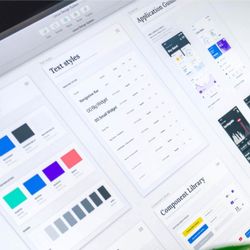Share

Design Driven
Quit Playing Games: How to Get the Right Message to Your Product Team
•
How do you ensure your team, across all departments, are on the same page to deliver the right message? We’re discussing this and a whole lot more on the latest edition of Design Driven.
Join host J Cornelius and guests, Nicholas Petroski, co-founder of Promethean Research, and Bureau of Digital’s Carl Smith for tips on how to save time and money by getting everyone on the right page, right away.
If you are leading a product team, organizing stakeholders, or considering your next product design project, this podcast from these UX leaders should not be missed.
More episodes
View all episodes

4 Reasons Your Design System Will Fail
26:48|On this episode of Design Drive, J, and Cathy, Nine Labs' design director, discuss dysfunctional operational processes and how they can affect your design system implementation.
How Cognitive Load is Hindering Your UX
35:13|This time of year is full of distractions for your Customers and your Colleagues, and believe it or not, completing simple tasks on an app may be much more challenging for users than ever imagined. A Human-Centered Design approach must consider the effects of Cognitive Load on users. This measurement of how much force we put on our brains to complete a task can have a big impact on your product’s UX. Check out our latest episode of Design Driven for insights on why Cognitive Load matters, how to segment information to overcome outside pressure, why 7 is the magic number…and much more.
Obstacles to Great Design
46:07|On this episode of Design Driven, design guru Greg Storey sits down with host J. Cornelius to uncover many of the issues preventing organizations like yours from achieving great design outcomes. The two discuss how the best-run organizations are overcoming those challenges to achieve great results.
The Intersection of Business and UX
35:50|The business case for UX Design is strong. Right? Better UX leads to quicker adoption, less cart abandonment, easier enrollment, and a frictionless payment process. A good User Experience is priceless. Isn’t it? If you’re nodding your head yes, you’re probably a Product Executive or Designer. On this episode of Design Driven, host J. Cornelius brings the conversation in-house to dish with our Senior UX Designer, Cathy Fisher about the intersection of Business, Functionality, and UX Design.
Level Up Your Product Management Team
34:33|In this episode of Design Driven, Equifax Chief Product Officer Mark Luber shares his must haves for creating a new app, a check list he’s created over 20 years in this business. That’s right, Mark was leading product before it was called product, and when many of today’s top UX talent were still surfing the worldwide web via a dial up connection. Listen in as this product leader and UX titan, shares the things you must consider before creating any new product.
Once Again, Design System to the Rescue
30:43|The benefits of a Design System have been well documented by us, and other really smart people. But did you know that implementing a design system can also help formulate a company voice & tone?On this episode of Design Driven, Beau Ulrey, Design Principal at US Bank, and host J Cornelius discuss how design systems benefit an entire company, not just the UX team. They also dive into what makes a great design team, and much more.Topics Include: Must-have skills for a high functioning Product Design Team.Content strategy as a defined discipline within UX Why designers and developers must work shoulder-to-shoulder to create an optimum User ExperienceNeed critical buy-in from your team for implementing a design system, today? Looking for the key players for a winning product team? Then this episode of Design Driven is not to be missed?
What Your Team is Missing About Design Thinking
43:49|The design thinking process is well documented and established. In fact, our most recent podcast guest, Wayne Li, was at the famous Stanford d.school when they helped create and document design thinking in the first place. At a high level, design thinking is when a diverse group of people with varying expertise can work harmoniously, steeped in a culture of trust, to make cool things (products, solutions, services) happen. However, even with a solid understanding of design thinking and efficient design practices in general, many businesses still miss the mark. Why? Because they forget two related things:Validation loops are essential to great product outcomesFlexibility in your development process is required By nature, design thinking is cyclical, not linear.The goal is to find the best possible solution or product to solve a problem, right? That requires gathering your diverse thinkers and brainstorming expansively. Then, going back to the ideas raised in your brainstorming session and examining them through a critical, deductive lens. You may need to go back and forth and round and round (hence the validation loops) to land on the best possible solution.See how design thinking needs to be flexible to work effectively? Yes, there are prescribed phases. But ultimately, your team has to be willing to evaluate what’s in front of them at any given time, and even take a step backward before pushing on. And therein lies the problem. It’s hard for people to work in this non-linear way. It goes against our neurological instincts. In our latest podcast, host J Cornelius and guest Wayne Li talk more on optimizing your design processes from a human perspective. Topics Include: How those in academia (which brought us design thinking) approach design challenges What football and improv comedy have in common — and what they tell us about how we should handle projects How working as a unit — not in departmental silos — leads to innovative ideasAbout Wayne LiWayne Li is a professor of design and engineering at one of the world’s premier design schools, Georgia Tech. There, he leads joint teaching initiatives and advances interdisciplinary collaboration between mechanical engineering and industrial design. Prior to becoming a professor at Georgia Tech, Li worked for Pottery Barn in innovation and market expansion. Impressively, he also taught for Stanford University’s design program — the same school that first ideated design thinking. Overall, Wayne generates significant profits, expands market penetration, and drives innovation in all his roles. His strong brand management, product differentiation, and design strategy experiences are unmatched. Learn more about Wayne Li and connect on LinkedIn.
How Digital Banks Will Fight Fraud in the Future
25:16|When was the last time you visited a physical bank branch and talked to a real live human about your account? It's probably been a while — and that’s the point. The fintech world is becoming more digitized all the time. Eventually, there won’t even be brick-and-mortar banks. That’s all well and good. But, as we innovate the future of banking, we need to consider how to fight fraud online. Unlike in-person banking, digital banking doesn’t allow for a teller to verify someone’s ID with his own two eyes. In reality, it's not as scary as it sounds. Depending on how you think about it, there are more ways to detect fraud online than in person. You can track IP addresses, phone numbers, emails — and you can verify them all instantly. One hold up to fully digital banking (and transactions in general) remains: Your social security number. Those little paper cards with that long-form number have been used for ages as our unique identifiers. But really, SSNs have been breached so many times that they’re not an ideal universal identity option anymore. So, what’s next? In our latest podcast episode, host J Cornelius and guest Heidi Hunter reveal the future of identity verification for fintech companies and users alike. You’ll Also Learn: The importance of detecting fraud while providing a friction-free user experience. A three-tiered approach to innovation for customer-facing fintech companies. Hint: It involves sales, support, and biz collaboration. What tokenized IDs mean for the UX of transactions. About Heidi Hunter Heidi Hunter is the Vice President of Product Innovations at IDology. In her nine plus years with the company, she’s steadily (and impressively) moved up the ranks.IDology is a leader in digital identity verification and authentication, and Heidi is a trusted expert on and innovator of ID and fraud prevention solutions. Additionally, Heidi has a proven track record in client consulting, strategic partner management, and data science. She has also developed SaaS and deployed several successful, intricate client applications.